Japanese beetles can destroy the bulk of your garden crop in just days. They not only have a devastating impact on growing plants, but are extremely difficult to get rid of.
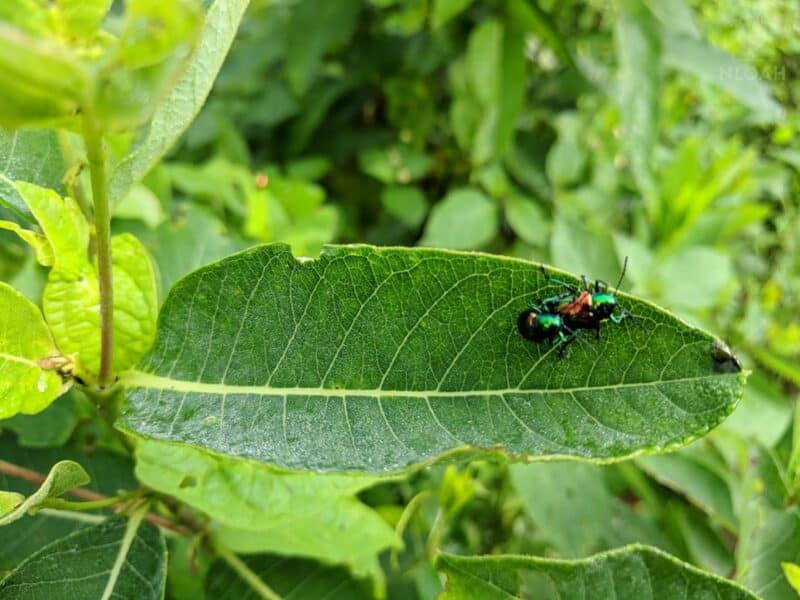
Short of standing in your garden around the clock plucking the Japanese beetles off the plants and squishing them beneath your feet, there is no surefire way to destroy them all in one fell swoop.
If you are diligent in your efforts, you can at least curtail the damage they inflict on the crops.
It does not take harsh chemical pesticides to get rid of Japanese beetles, odds are you have all the supplies necessary sitting on a shelf right now.
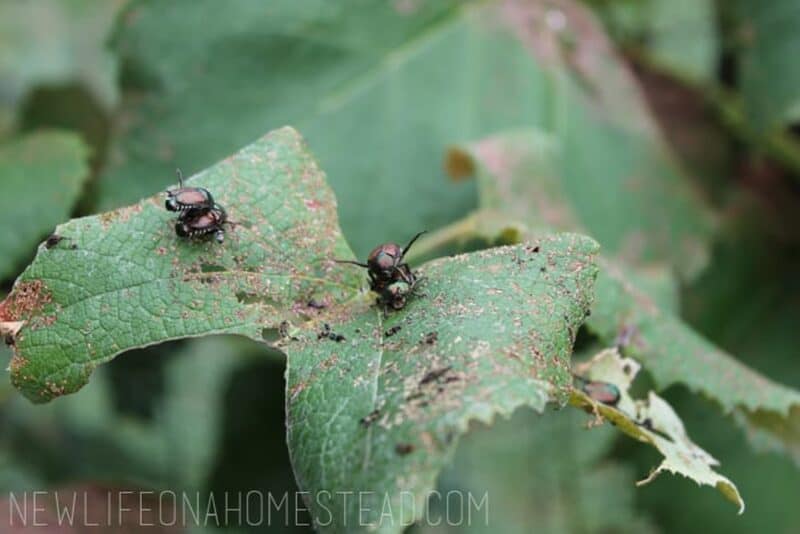
This photo of part of our garden was taken on a Sunday morning. The growing plants look picture perfect and showed signs a bountiful harvest would indeed be coming:
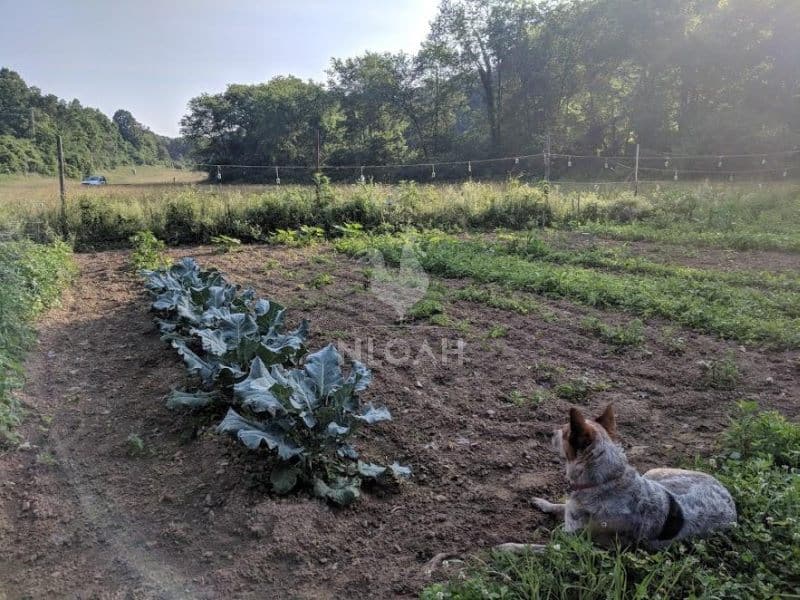
Broccoli Plant After Japanese Beetles:
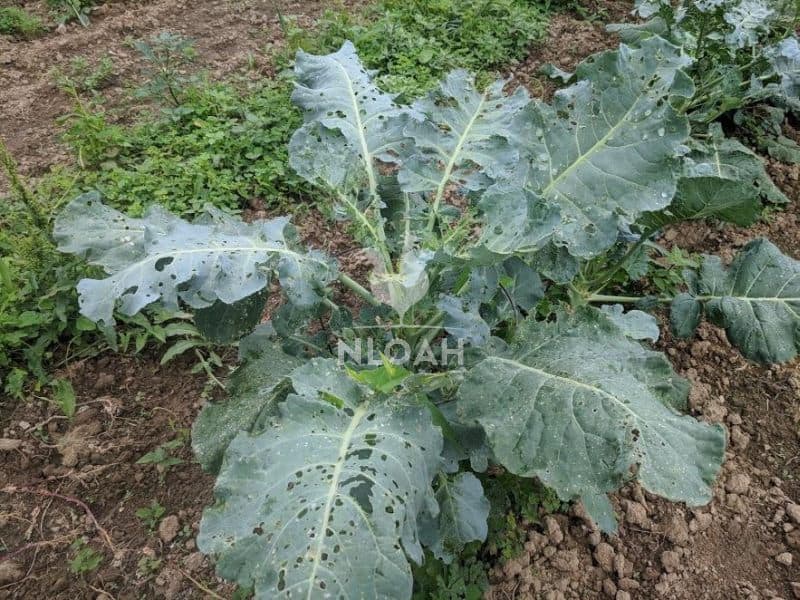
These photos were taken on the following Wednesday afternoon – after the Japanese beetles moved in.
This close up image of broccoli leaves above illustrate what a plant will look like after Japanese beetles begin feeding on it. This is a far too familiar sign to homesteaders and farmers that they now have a monumental problem on their hands.
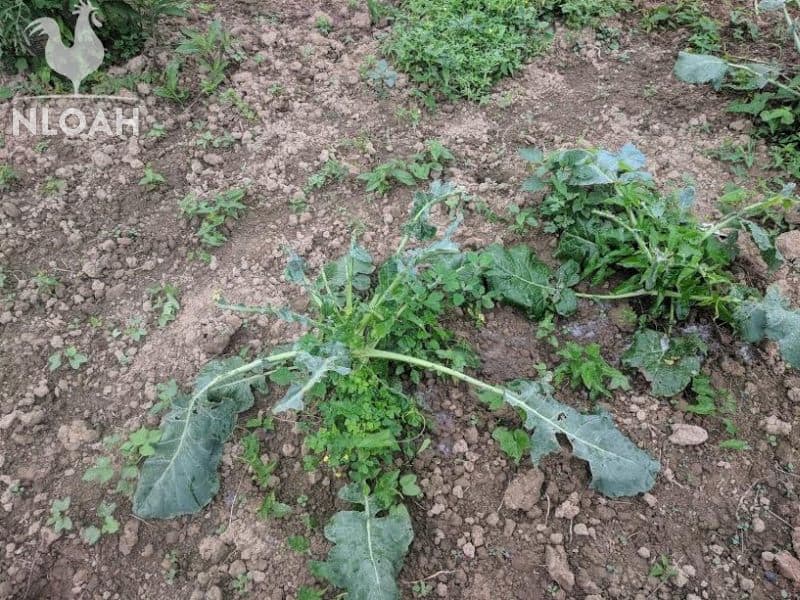
Here are the plants on video:
We thought we had dodged a bullet with Japanese beetles this growing season due to the preventative measures taken in the spring right after putting our plants in the ground.
Killing the larvae before they can mature into adults is a huge part of the battle when dealing with this beetle population.
Japanese Beetles Facts
Before you can effectively deal with Japanese beetles, it is essential to learn more about how they develop and what plants they both loathe and love…
| Genus | Popillia |
| Latin name | Popillia japonica |
| Width | 0.4 inches (10 mm) |
| Length | 0.6 inches 15 mm |
| Lifespan | 30 – 45 days |
| # of legs | 6 (= 3 pairs) |
| Wings color | copper |
| Do they bite humans? | no |
| They are repelled by | neem oil, chives, garlic, peppermint oil |
| Toxic plants for them | Geranium |
| Eggs size | 2 mm in diameter |
| Do they fly? | yes |
| Eyesight | poor |
| What eats Japanese beetles? | spiders, assassin bugs, sparrows, blue jays, robins, ducks, ants, ground beetles |
The shiny green and copper-colored beetles are tiny, but the threat to your growing food supply is enormous. It would be far easier to create a list of plants Japanese beetles won’t eat, than ones it will.
They are listed as a threat to literally hundreds of different crops, fruit bushes, and flowers. Only a few different varieties of trees and plants will help repel them. While the beetles can be found most anywhere in the United States, their largest colonies exist in both the Midwestern and Eastern regions of the United States.
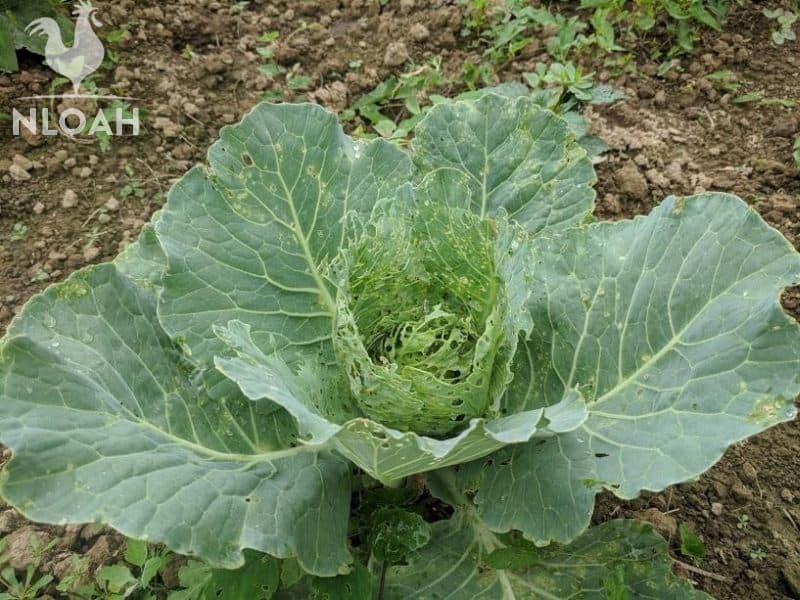
It is soundly believed that Japanese beetles were introduced to America quite by accident during the early 1900s. Prior to that date, the crop-devouring beetles roamed only among the Japanese islands.
Because the beetles were isolated to Japan by water and their natural enemies in the natural world, their populations didn’t rage nearly out of control.
Sometime around 1912 a new law was passed in America that forbid the importation of plants that came rooted in soil. But, the government did a poor job of regulating the law and the Japanese beetles are believed to have hitched a ride to the United States on potted iris plants when they were mere grubs.
Although efforts to kill off all of the Japanese beetles in America were in full swing by 1916, the government abandoned its effort to eradicate the pests by 1920. The little Japanese beetle had proven itself just too durable a foe to completely vanquish.
How To Identify Japanese Beetles
- The beetles are approximately half an inch long. They are about half an inch wide, too. These pests have copper-brown wing covers along with white spots of hair beneath those covers.
- Their heads are a shade of green or blue-green and cast a metallic hue.
- Mature beetles lay their eggs directly into the dirt in early June. During this time, they will also start eating. As a result, they will do the most damage beginning in late June for about four to six weeks.
- Young Japanese beetles are known as grubs. Their bodies are white, their heads are brown, and they have six legs. The young beetles are approximately three-quarters of an inch long.
- The beetle grubs remain buried in the soil for about 10 months – over the winter until they mature into adults and burrow up out of the soil to begin feeding.
- Japanese beetles almost always feed in small groups, meaning a host of them will attack a single plant together – the primary reason why an infestation becomes severe in an especially short amount of time.
- The average life cycle of a Japanese beetle is roughly 40 days.
- One of the few natural predators the beetles have in the United States is the yellow jacket.
- The beetles typically start eating at the top of a plant and work their way down to the roots.
- Japanese beetles are usually most actively eating on hot sunny days and seem to prefer eating crops that grow in full sun.
- There are over 300 different types of plants that these pests will eat. They can totally destroy flowers, leaves, and wounded fruit, feeding in masses as they start at the top of the plant and work their way down.
- Japanese beetle larvae will leave brown, deadened spots on your lawn.
21 Plants Vulnerable To Japanese Beetles
Geraniums are a favorite snack of beetles. Cultivate a border around your growing areas using geraniums to entice the destructive invades to munch on the plants instead of your thriving food crops.
Interestingly, although Japanese beetles are attracted to geraniums, geraniums emit a substance that paralyzes these pests temporarily – it can make them more vulnerable to predators.
Japanese beetles live underground and feed on the roots of plants as larvae. You might notice these pests feeding on your lawn when there are spots of dead or dying grass. However, as adults, they feed on just about everything.
| Broccoli | Green Beans |
| Cabbage | Grapes |
| Raspberries | Roses |
| Birch Trees | Soybeans |
| Rhubarb | Asparagus |
| Apples | Apricots |
| Cherries | Peaches |
| Plums | Hibiscus |
| Roses | Japanese maple |
| Norway maple | Pin Oak |
| Crape myrtle |
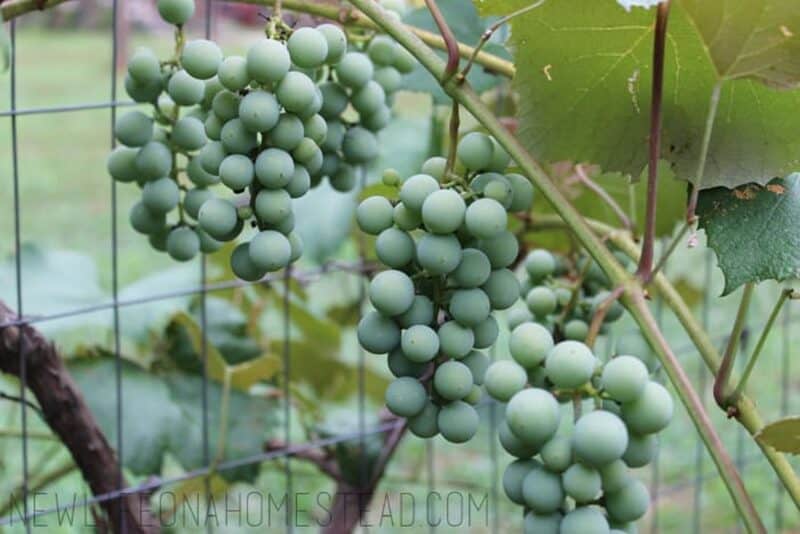
Top 7 Plants That Repel Japanese Beetles
Cultivate these plants around the crops most vulnerable to Japanese beetles to help deter a potential infestation:
1. Garlic
2. Onions
3. Leeks
4. Chives
5. Chamomile
6. Marigolds
7. Catnip
In addition, Japanese beetles tend to stay away from plants like ash, burning bush, dogwood, forsythia, holly, lilac, northern red oak, pine, red maple, spruce, yew, redbud, magnolia, hemlock, and clematis.
While planting these plants won’t necessarily repel Japanese beetles, planting options that are unattractive to the pests can help cut down on your losses.
How To Get Rid Of Japanese Beetles
Get the Birds Involved
Got chickens/ Great! Chickens will eat Japanese beetles to an extent, but want to know a type of poultry that will work even better? Guinea fowl.
Guineas can be quite loud, but they are effective at getting rid of tons of different garden pests, including ticks, Asian lady beetles, and, of course, Japanese beetles.
You can also attract ducks and other birds to your yard to munch on your Japanese beetle problem, even if you don’t want to maintain a backyard flock. All you need to do is spray your lawn with a soapy mixture of two tablespoons of dish soap to one gallon of water. This cocktail will force the beetles to the surface, which will then attract hungry birds.
The best time to do this is in the late spring and fall when Japanese beetles are in the larval stage. You can do this once a week and stop when the larvae stop emerging from the soil.
Use a Vacuum
While many people use the hand-picking technique to rid their gardens of Japanese beetles, you can also use a vacuum to get the job done. We will talk more about hand plucking in a moment, but know that using a vacuum can be a quicker way of getting rid of the pests. Dump the bugs in soapy water to kill them.
Take Good Care of Your Plants
If you love to garden, you probably already take pretty good care of your plants. However, know that Japanese beetles are most attracted to overripe or rotting plants.
Maintaining a healthy, clean garden is the easiest way to keep Japanese beetles at bay. Remove ay plants that are diseased or dying – leave them there, and they’ll attract beetles to your yard. You should harvest plants before they become attractive to the Japanese beetles, too.
Use Row Covers
Row covers are incredibly beneficial to the home gardener. They let air, water, and sun reach your plants – yet they keep annoying pests like Japanese beetles far, far away.
To use row covers effectively, you need to make sure the edges of the cover are flush with the ground and firmly sealed. Unfortunately, if Japanese beetle grubs have already taken over, this method isn’t going to be very effective, as it will simply trap the grubs within the soil.
Hand Plucking
This is the most time-consuming way to get rid of Japanese beetles, but it does work well. Invite the family and friends over to your homestead for a Japanese beetle plucking work detail – cookout.
Simply walk around your garden plot or growing area and find plants that have been eaten by the beetles. As noted above, they are most active during the heat of the day.
Start at one plant at the beginning of the row and look it all over, plucking all the beetles you can find from the plant. Step on the beetles and stick the dead ones in a sack to hang a stake near the row.
Puncture a few holes in the sack to the smell of decomposing beetles can be sniffed by other members of their colony.
Typically, the beetles will not enter an area that smells like their dead unless they are starving – an old farmer shared this tidbit of information with me and it seems to work at least somewhat.
Introduce Beneficial Nematodes
One of the best ways to reduce pests in a natural way is to introduce parasitic roundworms. Nematodes can wipe out a whole population of soil-dwelling pests like Japanese beetles.
These worms will locate and enter a host, with the microscopic worms releasing bacteria that will kill off the young beetles almost instantaneously.
And they don’t stop there. Once they’ve left a host, they will move on to another beetle and then reproduce. They are killing machines!
To experience the best results, you should introduce nematodes in late August or early September. This will rid your soil of beetles for the following year, stopping the cycle in the process. That being said, you can technically introduce nematodes at any time throughout the year – just make sure your soil is sufficiently watered.
If you choose nematodes to take care of your Japanese beetle problem, always go for the species Heterorhabditis. This is the most effective Japanese beetle treatment, as it targets larvae and not adults. You can find most nematodes at your local home and garden store.
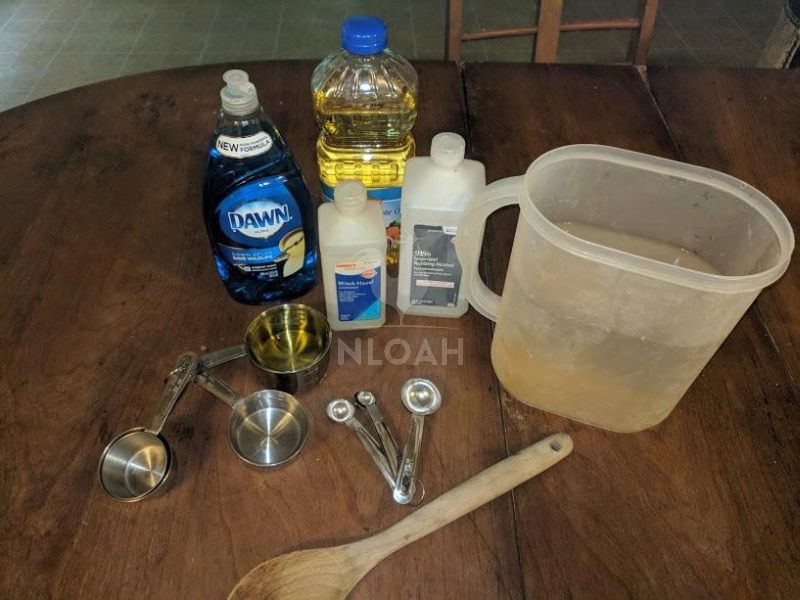
DIY Japanese Beetle Spray Recipe #1
- Mix together 1 cup of vegetable oil (carrier oil like olive oil works well too) with 1 cup of dishwashing soap (Blue Dawn seems to work best) 1 cup of rubbing alcohol, and 2 quarts of water.
- Pour the mixture into a jug with a firm-fitting lid or an agricultural sprayer.
- Shake vigorously
- Spray or pour onto the plant once every 5 to 7 days. Apply the mixture during the morning hours when dew is still on the plants and not during the heat of the day to prevent scorching. If the crops show signs of wilting after the sun has been out for a few hours, rinse the plant with lukewarm water and tone down the rubbing alcohol in the next batch.
DIY Japanese Beetle Spray Recipe #2
This recipe works well because garlic is very unattractive to Japanese beetles. This recipe can also help repel other pests, too!
- Mix together up to 1 tablespoon of mineral oil and 1 garlic bulb or up to 1 tablespoon of garlic powder. If using fresh garlic, allow the mixture to soak overnight and strain the garlic before moving on to step 2.
- Fill a jug with 2 cups of water and add in 1 tablespoon of Blue Dawn – or your favorite liquid dish soap.
- Combine both mixtures into an agricultural sprayer or jug with a firm-fitting lid. Holes can be poked into the lid of the jug so it can become a delivery method for the “spray” so you can sprinkle it over the plants.
- Spray or shake the natural insecticide directly onto the entire plant during the morning hours.
- This spray should work well to deter not only Japanese beetles but also cabbage loopers, June bugs, aphids, earwigs, whiteflies, squash bugs, and leafhoppers.
- Apply once or twice a week – or as necessary.
Recipe #3: Flour And Salt Powder (careful, check out the photos and comments below)
Mix together 2 cups of flour and 1 cup of salt (standard table salt works fine) and sprinkle it liberally onto plants. As with the sprays above, do the powder sprinkling during the morning hours.
The Japanese beetles, cabbage loopers, and other insects will consume the flour and salt mixture and then their stomachs will bloat until they burst, killing the garden pests.
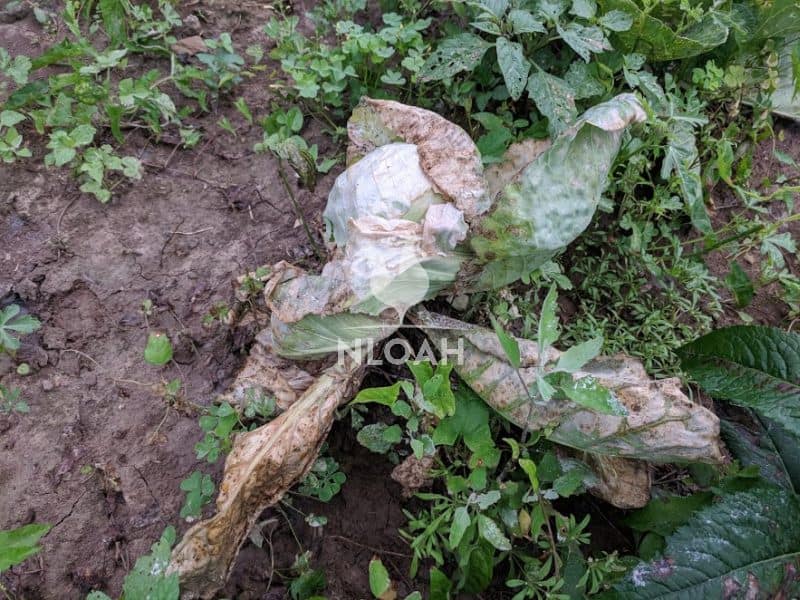

These cabbage photos above show what happens when you use the flour and salt mixture when it is too hot and humid. Even though I followed the strong recommendation to apply the salt and flour herbicide during the early morning hours when there is still dew on them to allow it to soak in and avoid scorching, the plants still got scorched.
I also applied the mixture before it was 85 degrees, as recommended. Because we are in the midst of a heat wave, it hits 5 degrees early, usually before 9 a.m.
The beetles were killing the plants, so the risk of scorching them was one I was willing to take. I reduce the amount of salt to help prevent a negative outcome, but as you can clearly see, scorching occurred just the same.
The plants do not appear to have died, only time will tell if they will produce anything or not. But, the liquid sprays I used in the videos as well as the flour and salt mixture, have kept the Japanese beetles and other bugs away. I have only seen beetles on two tomato plants I did not put any treatment on – using them as a kind of control group.
Use a Drop Cloth
Drop cloths can help cut down on Japanese beetles, too. All you need to do is cover your plants at night with a large drop cloth. In the morning – which is when Japanese beetles are the most active – you can remove the cloth and kill the attached beetles with a bucket of soapy water.
Use Cedar Oil
Cedar oil is said to be very unattractive to Japanese beetles. You can purchase or make your own. All you need to do is place a few foot-long red cedar planks in a two-gallon bucket.
Pour hot water on the plants and let them sit for a full day. Make sure the planks are covered and then pour the liquid into a spray bottle before applying the liquid to your plants.
Grub Killing
During the spring, spray the garden area with a mixture of 1 gallon of water and 2 tablespoons of liquid dishwashing soap – Blue Dawn highly recommended. If the ground is not too hard or dry, the grubs buried slightly below the surface will rise above ground and be eaten by birds. This recipe should yield enough spray to cover 2,000 square feet.
If you have had significant Japanese beetle issues in the past, spray this mixture once a week in the spring and again in the late fall before winter sets in to kill as many grubs as possible.
Companion Planting
I already told you about the plants that Japanese beetles don’t like above. You can use targeted companion planting to keep these pests away, too. Some are even poisonous to Japanese beetles! You will want to plant items like rudbeckia, geraniums, yellow carpet roses, and other deterrents for best results.
Milky Spores
Purchase milky spores (a fungal disease sponge-like garden product) to kill the larvae of Japanese beetles. The young beetles consume the spores as they grow under the ground.
This method of killing a mature colony before it starts works well, but it generally takes up to three years before the milky spore content in the ground will be strong enough to kill the larvae that ingest it.
Once the milky spore count peaks, it should remain in the soil at a potent enough rate to kill beetle larvae for two years.
The other drawback to this eradication project is the cost. Milky spores are far more expensive than the other natural insecticide ingredients and this list and it takes a whole bunch of them to treat a typical garden area.
Use Parasitic Wasps
Parasitic wasps can be helpful in getting rid of Japanese beetles. Just keep in mind that these only attack the larvae and are not necessarily predators of adult beetles.
Plant Deep-Rooted Grasses
Naturally, one of the easiest ways to prevent and repel Japanese beetles is to kill them before they become full-grown, adult beetles. Plant deep-rooted grasses like tall fescue.
These will require watering only once every seven to ten days – therefore, you will have a lessened likelihood of the grubs being drawn to your yard. Tall fescue also tends to be more resistant to grub damage.
Neem Oil
Neem oil doesn’t kill Japanese beetles instantaneously, but instead suffocates them over time. It is a pest deterrent that works well on other pests, too, like grasshoppers, tomato hornworms, and leafhoppers. Simply spray your plants often for best results. It won’t harm your plants or any beneficial insects.
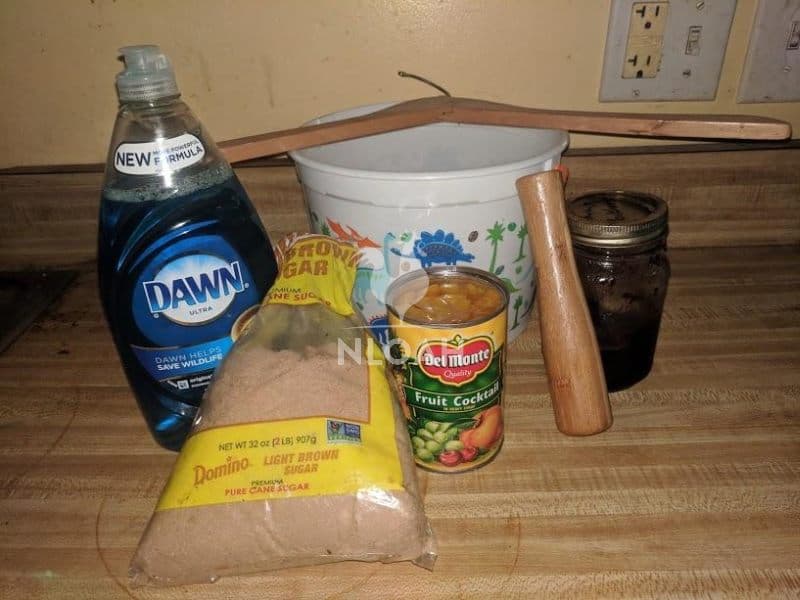
Japanese Beetle Trap
- Open up a can of fruit cocktail, canned fruit, or pick/purchase fresh fruit and place it outdoors in a sunny spot until it ferments – becomes somewhat rancid. If you are using canned fruit cocktail or fruit, this process may take up to 7 days. You can also add in jelly, jam, vanilla extract, or brown sugar to help make the bait for the trap both thicker and sweeter.
- Pour a few tablespoons of Blue Dawn (or other liquid dish soap) into a bucket.
- Place a board or something equally heavy onto the top of the bucket.
- Mark the space where the board lays over the center of the bucket.
- Slather the fruit and sweet mixture on only the bottom side of the board so the Japanese beetles (and other pests, especially yellow jackets) have to maneuver upside down and remain in that position while they gorge on the bait.
- The beetles will become heavy, tired, and have difficulty with both their sense of balance and direction as they attempt to leave the rancid fruit buffet.
- The loss of balance and sense of direction should cause the Japanese beetles to fall to their deaths in the water waiting below.
- The water level in the bucket should be no more than 1 inch below the bait.
- Place the trap about 10 feet from crops where Japanese beetles are prone to visiting or have already set up housekeeping. You want to draw them away from your crops rows and not towards them. Usually, the younger the beetle, the more effective this trap is in killing them.
The dish soap is added to the water to make it more permeable and prevent the Japanese beetles and other crawling or flying insects, to save themselves from drowning.
This trap will also attract yellow jackets, who will likely kill at least some of the beetles while visiting the trap.
Diatomaceous Earth
This natural and inexpensive Japanese beetle and garden pest control option is comprised of fossilized seashells. The minuscule yet highly sharp fragments in the diatomaceous earth will puncture the bodies of beetles (and most all other garden pests) both internally and externally as well as provoke deadly dehydration to occur.
Simply sprinkle the diatomaceous earth (DE) around (not on) the plant and between rows so any beetles or pests that crawl or walk past it, have their bodies coated in the powder, even if they opt out of directly consuming it.
Japanese Beetle and Garden Pest Drench
- Mix together equal parts garlic (fresh or powder) horseradish, green onions, crushed peppercorns, and hot peppers.
- Stir enough water to make a spray or broth-like consistency.
- Pour in 1 tablespoon of Blue Dawn – or other liquid dish soap.
- Spray onto plants during the early morning hours and between plants, for best results.
- Repeat as needed, typically two applications a week are necessary to thwart Japanese beetles and other determined garden pests, like the cabbage looper.
Caution!
Most sprays or dusting powders designed to kill Japanese beetles and other common garden pests are also extremely toxic to the incredibly beneficial honeybee.
To reduce honeybee carnage as much as possible, apply the sprays and dusting powders only when essential and not during the spring blooming period when visits by honeybees are most crucial.
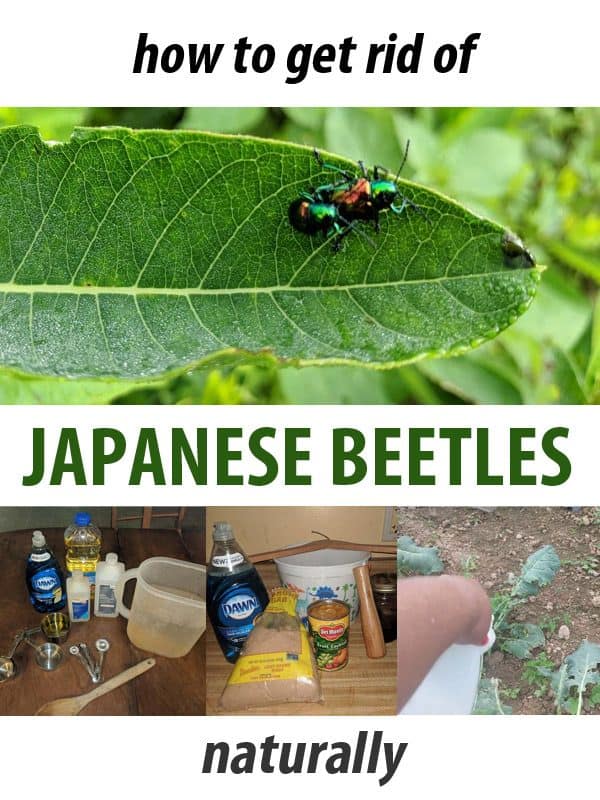

Tara lives on a 56 acres farm in the Appalachian Mountains, where she faces homesteading and farming challenges every single day, raising chickens, goats, horses, and tons of vegetables. She’s an expert in all sorts of homesteading skills such as hide tanning, doll making, tree tapping, and many more.

Garlic juice as spray works too, keeps the mosquitoes away as well
Thank you for all the tips! We lost all our apples last year due to Japanese beetles – the apples rotted on the tree. There’s a huge infestation again this year. We tried setting pheromone traps but have since read that they can make things worse by drawing the beetles into your area. I want to give your sprays a try.
My husband wanted a way to kill and reuse those traps and talked about putting them in the freezer. I said we should just leave the beetles in the freezer – and our chickens would then have a tasty snack in the wintertime 🙂 They LOVE the Japanese beetles and go nuts when we shake our trees so the beetles fall to the ground. (Meanwhile, I have a couple freezer bags full of bugs – egads!)
Carmen,
I hope my sprays work for you and your husband as well as they worked for me. Those beetles sure can kill a potential harvest quickly. I love that you have freezer bags full of bugs, how clever! Chickens do love them so you are providing a great source of natural protein to their diet without costing you a dime – and getting some great revenge on those dang Japanese beetles in the process!!